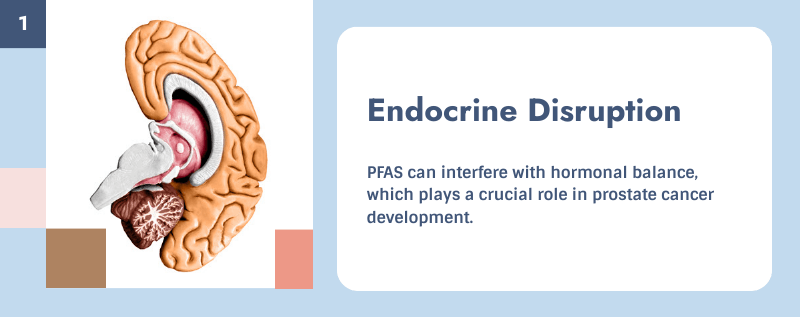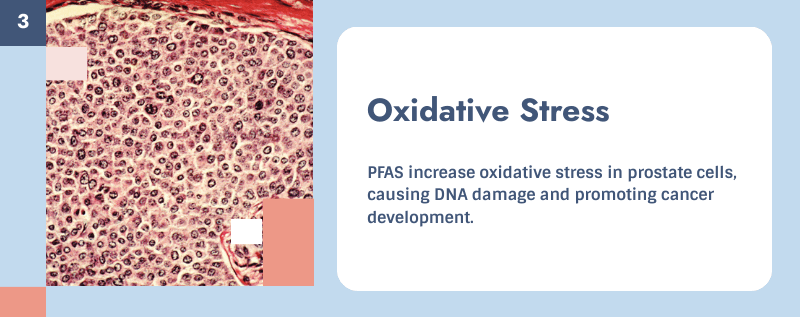Introduction
Per- and polyfluoroalkyl substances (PFAS) are synthetic chemicals that have become pervasive in industrial manufacturing, consumer products, and the environment. These “forever chemicals” have raised significant health concerns due to their persistence and potential to bioaccumulate in human tissues.
While much research has focused on PFAS’s links to kidney, liver, and immune-related disorders, emerging studies suggest a strong association between PFAS exposure and prostate cancer – one of the most common cancers in men worldwide.
Prostate cancer is influenced by a variety of factors, including genetics, hormonal imbalances, and environmental exposures. PFAS, with their ability to disrupt endocrine function, induce oxidative stress, and cause cellular mutations, may play a significant role in the development and progression of this disease.
This article explores the mechanisms through which PFAS contribute to prostate cancer, reviews epidemiological studies linking PFAS exposure to increased risk, and provides guidance on reducing exposure to these harmful chemicals.
Understanding Prostate Cancer
What is Prostate Cancer?
Prostate cancer occurs when abnormal cells in the prostate gland begin to grow uncontrollably. The prostate, a walnut-sized gland located below the bladder, produces seminal fluid that nourishes and transports sperm. Prostate cancer can develop slowly and remain localized, or it can be aggressive and spread to other parts of the body.
Risk Factors for Prostate Cancer
- Age: The risk increases significantly after age 50.
- Family History: A genetic predisposition plays a crucial role in some cases.
- Hormonal Changes: Elevated testosterone and dihydrotestosterone (DHT) levels are linked to tumor growth.
- Environmental Exposures: Industrial chemicals, pesticides, and endocrine-disrupting substances, such as PFAS, are suspected contributors.
While traditional risk factors have been well-documented, scientists are now exploring how environmental pollutants like PFAS interact with hormonal and genetic pathways that regulate prostate health.
How PFAS May Contribute to Prostate Cancer
1. Endocrine Disruption and Hormonal Imbalances

PFAS are known endocrine disruptors, meaning they interfere with the body’s hormonal system. Given that prostate cancer is strongly influenced by hormonal signaling, PFAS exposure could play a critical role in tumor development.
- Testosterone and DHT Regulation: Research published in Environmental Health Perspectives (2021) found that PFAS exposure alters androgen receptor activity, leading to dysregulation of testosterone and DHT, both of which are implicated in prostate cancer progression.
- Estrogenic Activity: A study in Toxicological Sciences (2022) suggested that some PFAS compounds mimic estrogen, potentially increasing cell proliferation in hormone-sensitive tissues like the prostate.
2. Inflammation and Cellular Damage

Chronic inflammation is a known risk factor for prostate cancer. PFAS contribute to persistent inflammatory responses, leading to DNA damage and tumor initiation.
- Elevated Cytokines: A study in Cancer Epidemiology, Biomarkers & Prevention (2020) found that individuals with high PFAS blood concentrations exhibited increased levels of inflammatory cytokines such as IL-6 and TNF-α, both of which are associated with prostate tumor growth.
- Prolonged Immune Activation: PFAS exposure has been linked to immune dysregulation, creating an environment where inflammation becomes chronic and enhances the likelihood of malignant transformation in prostate cells.
3. Oxidative Stress and DNA Damage

Oxidative stress results from an imbalance between free radicals and the body’s ability to neutralize them. Excessive oxidative stress can damage DNA, leading to genetic mutations that promote cancer development.
- Reactive Oxygen Species (ROS) Formation: Research in Molecular Carcinogenesis (2019) demonstrated that PFAS exposure increases ROS production in prostate epithelial cells, causing oxidative DNA damage.
- Impaired DNA Repair Mechanisms: PFAS inhibit critical tumor-suppressor genes such as p53, making it more difficult for cells to repair DNA damage before mutations accumulate.
4. Disruption of Epigenetic Regulation

Epigenetic changes—modifications in gene expression without altering DNA sequences—have been increasingly implicated in cancer development. PFAS have been shown to induce epigenetic modifications in prostate cells.
- Histone Modifications and Gene Silencing: A 2021 study in Epigenomics found that PFAS exposure altered histone methylation patterns in prostate cancer cells, silencing tumor-suppressor genes.
- Altered DNA Methylation: PFAS exposure has been associated with hypermethylation of genes that regulate apoptosis (programmed cell death), making it easier for cancerous cells to evade destruction.
Studies Linking PFAS and Prostate Cancer
While laboratory studies provide mechanistic insights, epidemiological research has strengthened the case for a link between PFAS exposure and increased prostate cancer risk.
- C8 Health Project (2018): One of the largest studies on PFAS health effects, this research followed a cohort exposed to contaminated water in West Virginia. It found a statistically significant increase in prostate cancer diagnoses among participants with high PFOA (a common PFAS) blood levels.
- NHANES Study (2021): Data from the National Health and Nutrition Examination Survey (NHANES) indicated that men with elevated PFAS exposure had a 30% higher risk of developing prostate cancer.
- Occupational Exposure Studies: A study in Occupational and Environmental Medicine (2022) found that firefighters, who have prolonged exposure to PFAS through firefighting foam, had a significantly increased risk of aggressive prostate cancer.
- Veterans and Military Exposure Study (2023): A Department of Defense report revealed that veterans who served at PFAS-contaminated military bases had higher incidences of prostate cancer than the general population, leading researchers to call for further investigations into service-related environmental risk factors.
- Harvard University Study (2023): Researchers examined prostate cancer rates in individuals exposed to PFAS-contaminated drinking water in Massachusetts, confirming a correlation between long-term exposure and aggressive forms of the disease.
Reducing PFAS Exposure to Lower Prostate Cancer Risk
While completely avoiding PFAS exposure is nearly impossible due to their environmental persistence, individuals can take steps to minimize their risk.
1. Improve Water Quality
- Use NSF-Certified Water Filters: Reverse osmosis and activated carbon filtration systems can remove PFAS from drinking water.
- Test Your Water: If you live near an industrial site or military base, test your water for PFAS contamination.
- Avoid Bottled Water: Some bottled water brands have been found to contain PFAS, so opt for filtered tap water whenever possible.
2. Avoid PFAS in Consumer Products
- Choose PFAS-Free Cookware: Opt for ceramic, stainless steel, or cast-iron alternatives instead of nonstick cookware.
- Avoid Stain-Resistant and Waterproof Fabrics: Many textiles, such as carpets and outdoor gear, contain PFAS-based treatments.
- Check Food Packaging: Grease-resistant fast-food wrappers and microwave popcorn bags often contain PFAS. Opt for homemade meals or brands that specify PFAS-free packaging.
- Be Mindful of Personal Care Products: Many shaving creams and dental floss brands contain PFAS. Look for natural or certified PFAS-free alternatives.
3. Maintain a Prostate-Healthy Diet

- Eat Antioxidant-Rich Foods: Tomatoes (lycopene), green tea (polyphenols), and cruciferous vegetables (broccoli, Brussels sprouts) contain cancer-fighting compounds.
- Increase Omega-3 Fatty Acids: Found in salmon, flaxseeds, and walnuts, omega-3s may help reduce inflammation and slow cancer cell growth.
- Reduce Processed Foods: Ultra-processed foods and charred meats contain harmful chemicals that may contribute to oxidative stress and cancer progression.
4. Advocate for Policy Changes
- Support PFAS Bans and Regulations: Push for stronger state and federal restrictions on PFAS manufacturing and use.
- Engage in Community Action: Join local advocacy groups working to clean up PFAS-contaminated water supplies.
- Monitor Government Action: Follow regulatory updates from agencies like the Environmental Protection Agency (EPA) and the Food and Drug Administration (FDA) to stay informed on PFAS safety standards.
Future Actions
While there is still a lot of work to be done, there is a growing body of evidence linking PFAS exposure to prostate cancer which underscores the urgent need for regulatory action and personal risk mitigation.
Continued research and advocacy will be essential in holding manufacturers accountable and protecting future generations from the harmful effects of these persistent chemicals.






